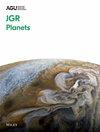河流改造消除了小陨石坑,但没有对火星互层陨石坑记录产生有意义的偏差
摘要
解释火星上暴露的地层记录的结构、形态和化学是复杂的,因为古老的地表过程已经改变了部分记录。先前的研究利用了与河流沉积物互层的较小陨石坑(直径≤${\le} $ 50米)的缺乏来限制火星上河流活跃时的大气压力;他们认为,较高的大气压力会阻止较小的陨石坑形成。我们假设,同时期的河道横向迁移和撕脱作用可能改造了沉积矿床,并从地层记录中消除了陨石坑,从而破坏了大气古压力的解释。为了验证这一假设,我们模拟了同时期河流三角洲的发育和陨石坑的产生,并量化了陨石坑在地层中的保存。我们记录了广泛的陨石坑边缘退化(~ ${\sim} $ 67)% of craters ≤ ${\le} $ 50 m at least partially eroded), and observe a marked increase in preservation with increasing crater diameter. That is to say, fluvial reworking preferentially removes smaller craters from the stratigraphic record. However, synthetic crater-diameter distributions incorporating fluvial reworking effects do not reproduce observations on Mars, because many smaller craters generated remain preserved in the simulated stratigraphy. We find that, although river channels are sometimes in the right place to eliminate crater deposits from the stratigraphic record, production of smaller craters outpaces fluvial reworking under all modeled circumstances, and that a higher pressure ancient atmosphere is necessary to reproduce observations (i.e., consistent with existing interpretations of interbedded crater records). Our findings therefore bolster studies that assert fluvial reworking is not a primary control on smaller interbedded crater counts on Mars.





Interpreting the structures, morphology, and chemistry of the exposed stratigraphic record on Mars is complicated by ancient surface processes that have variably removed parts of the record. Previous research has used the lack of smaller craters (50 m diameter) interbedded with fluvial deposits to constrain atmospheric pressure when rivers were active on Mars; the notion being that higher atmospheric pressure would have prevented smaller craters from forming. We hypothesize that contemporaneous channel lateral migration and avulsion could have reworked sedimentary deposits and eliminated craters from the stratigraphic record, thereby undermining atmospheric paleo-pressure interpretations. To test this hypothesis, we simulated coeval river-delta development and crater production, and quantified crater preservation in resulting stratigraphy. We document widespread crater rim degradation (67% of craters 50 m at least partially eroded), and observe a marked increase in preservation with increasing crater diameter. That is to say, fluvial reworking preferentially removes smaller craters from the stratigraphic record. However, synthetic crater-diameter distributions incorporating fluvial reworking effects do not reproduce observations on Mars, because many smaller craters generated remain preserved in the simulated stratigraphy. We find that, although river channels are sometimes in the right place to eliminate crater deposits from the stratigraphic record, production of smaller craters outpaces fluvial reworking under all modeled circumstances, and that a higher pressure ancient atmosphere is necessary to reproduce observations (i.e., consistent with existing interpretations of interbedded crater records). Our findings therefore bolster studies that assert fluvial reworking is not a primary control on smaller interbedded crater counts on Mars.

 求助内容:
求助内容: 应助结果提醒方式:
应助结果提醒方式:


